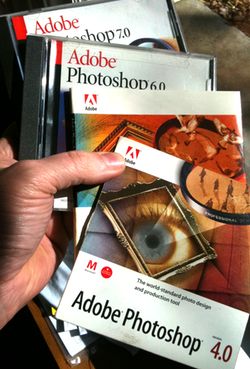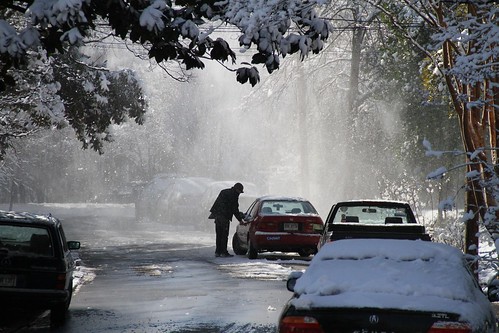William Shatner stands on guard for thee.
Sunday, February 28th, 2010
Photo by Duncan Rawlinson, one of many cool ones at his ‘Last Minute Blog’.
After speeches, anthems aplenty, and flags raised, lowered, and passed along, Neil Young sang “Long May You Run”, the Olympic torch was extinguished, and with it, any air of sobriety left in Vancouver’s BC Centre.
What followed was folly: William Shatner, with a dramatic reading plus Keynote presentation on what it means to be Canadian (ien?). Catherine O’Hara, swept in by curling brooms, with comedic variations on that theme, and an apology for being apologetic. Michael J. Fox, yet another sometimes-expatriate, tugged on a heart or two.
And then came the the giant inflatable beavers, the floating mermaids with maple leaf wings, and a gigantic tabletop hockey game, batting about a small child dressed as a puck. And moose. And canoes. And, oh yeah, Michael Bublé singing some snippet of maple leaf doggerel over and over again accompanied by mountie babe backup singers…segueing into the famed Hockey Night in Canada theme.
And how did it all end?
Well, we don’t quite know, on this side of the border. At 10:30 eastern, NBC did their best attempt at self-parody: they cut away (abruptly!) from the ceremony, promising to pick up where they left off in a hour—on, yes, say it with me, tape delay. had to run that Seinfeld Marriage game show thingie, y’know.
After that odd acid trip of an experience, it’s hard to believe Seinfeld was ‘More colorful.’
Converged, 20 years on.
Thursday, February 18th, 2010
 Friday, February 19th is the 20th birthday of Photoshop. Yes, the software that liberated me from paint systems that cost six figures is two decades old, and in that staggeringly long time (when you measure in ones and zeroes) has grown from a simple way to make and alter bitmapped images to a complex, multilayered, largely 3d and multiframed behemoth that has all kinds of horsepower to handle massively megapixel-y frames of stuff in lots of different formats.
Friday, February 19th is the 20th birthday of Photoshop. Yes, the software that liberated me from paint systems that cost six figures is two decades old, and in that staggeringly long time (when you measure in ones and zeroes) has grown from a simple way to make and alter bitmapped images to a complex, multilayered, largely 3d and multiframed behemoth that has all kinds of horsepower to handle massively megapixel-y frames of stuff in lots of different formats.
It also, increasingly, has the tools to help ordinary joes create retouched reality that is nearly undetectable except by those who examine their work on a fractal/pixel level.
I spoke at a SMPTE conference 20 years ago about how to use the tools of the time to work with multigenerational video to create layers of graphic design (back in a time where television’s on-air look was distinguished by a distinct lack of layering. The demo I showed used the state-of-the-then-art, a $160,000 Quantel Paintbox, to create text, color gradients, and the raw material that I would layer into multigenerational creations. And this was a device that could only work at the (amazingly low) resolution of standard definition (ah, we used to call it NTSC) television.
A month later—a month later—Photoshop was released. And yes, that changed everything.
So in 1993, I gave a talk to a bunch of NBC promo execs (back when they could have deluxe retreats and talks) about everything having been changed, and I, well, kinda geeked out about the possibilties of working with desktop systems and this cool program called Photoshop and vector files and a new compositing program called COSA After Effects. I went on at some length, and in a terrifying amount of detail, as I’ve been known to do, and, well, I suspect I baffled more than enlightened my audience, but now here we are.
Everyone knows the word Photoshop, and most use it as a generic to mean “mess with an image.” There are websites that celebrate and call out the overuse and misuse of the venerable application’s powers. There are songs—not very good ones, or I’d link to them—venerating and trashing the app.
So thanks, Knoll brothers and Adobe, for extending what was only the work of a few specialists now into the grasp of nearly anyone with a laptop in a coffeehouse. And as we sit here in the ‘now’ where fancy tablet computing thingies are about to ship that may well open up even newer digital highways for those who find computers way too computer-y and spell the sunset of some of the desktop machines we’ve delighted in for two decades, I’ll still, I suspect, be firing up the venerable program most mornings to design cool things. Or scribble, as I search for an idea.
Oh, and if you (uh, as I do) like to see computer guys who were young punks when they invented the thing get together decades later to reminisce, please enjoy John and Thomas Knoll, Russell Brown, and Steve Guttman sitting around talking.
Snow cliché 2010!
Saturday, February 13th, 2010
Run for your lives! Well, on second thought, don’t. We had four inches (expert meteorologists…top men, I tell you..told us) of frozen precipitation, which, I think in the greater country-wide scheme of things, means we got off very lucky indeed. We were able to get up to my dad’s 84th birthday yesterday through the snowy beauty with nary a skid, and when the sun rose today, it was a good time to get out and shoot a few pictures.
…and there are a few more here.
Sapelo weekend.
Tuesday, February 9th, 2010
 Back from a weekend hanging with archaeologists and looking at things archaeological down on the Georgia coast. On Sunday morning, we took a ferry over to Sapelo Island, one of Georgia’s barrier islands that has (they tell me), been intensely occupied over the centuries, from native peoples who built shell ring mounds (one 100 meters in diameter) way way back in BC sometime to the Spanish to the French to sugar cane growers who forged their operations on the backs of slave labor to the descendents of those slaves (and, along the way, a Detroit auto engineer who bought up a big chunk of the island, North Carolina tobacco emperor R.J. Reynolds who built a big old house there, and bunches of researchers, some who live on the island full-time.)
Back from a weekend hanging with archaeologists and looking at things archaeological down on the Georgia coast. On Sunday morning, we took a ferry over to Sapelo Island, one of Georgia’s barrier islands that has (they tell me), been intensely occupied over the centuries, from native peoples who built shell ring mounds (one 100 meters in diameter) way way back in BC sometime to the Spanish to the French to sugar cane growers who forged their operations on the backs of slave labor to the descendents of those slaves (and, along the way, a Detroit auto engineer who bought up a big chunk of the island, North Carolina tobacco emperor R.J. Reynolds who built a big old house there, and bunches of researchers, some who live on the island full-time.)
On the ferry over (a zippy modern catamaran named after Katie Underwood, the island’s last resident midwife), three kids from what seemed like widely variant socialeconomic backgrounds (that is, some seemed to be dirt-poor and some didn’t) nevertheless had iPhones or iPod Touches, and they and their friends exhibited the now-familiar behavior “look at this cool app! look at this picture I just took of you! listen to this song!” Modern mobile kids, doing the new social, poking, pinching, and sliding on tiny glass surfaces.
Once on the island, at least for us, it was a decidedly low-tech wander, packed into a beat-up minivan, bouncing along dirt roads with deep puddles from Friday’s rain. We did collect lots of GPS points and digital photos, and we learned about the island’s history the old-fashioned way, listening to the stories of those who had spent decades investigating the centuries of human occupation on the island.







